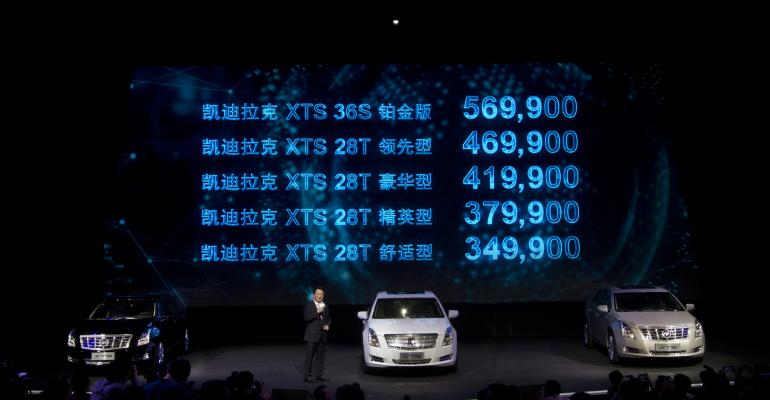TAIPEI, Taiwan – The 4% devaluation of the Chinese renminbi against the U.S. dollar announced Aug. 11 by the People’s Bank of China has triggered much speculation on how the country’s automotive ecosystem will be affected.
As the dust settles and the Chinese currency stabilizes somewhat, experts say that contrary to textbook economics, which contends importers always lose and exporters always win when the local currency weakens, the developments are not necessarily bad for foreign auto brands in the China market. This is especially the case for the European premium segment, where consumers are less sensitive to modest price changes, experts say.
Against the backdrop of slower economic growth in China, sales in the world’s biggest auto market have been sluggish of late. Light-vehicle deliveries in July decreased 7.7% year-on-year to 1.44 million but were off just 1.9% year-to-date, according to WardsAuto data.
“Intriguingly, some European brands could actually benefit as certain consumers may prefer to buy cars than hold onto currency, especially if price rises are expected,” says Neil King, an automotive analyst at London-based market researchers Euromonitor International.
“Although not as extreme, this is not dissimilar to the situation in Russia where premium brands that produce locally have suffered less than the (Russian) overall market collapse” amid that country’s ongoing recession.
King adds that while price reductions are not out of the question, he still would expect to see OEMs looking more toward offering incentives such as deposit subsidies, more attractive finance deals or higher levels of standard equipment or servicing packages.
Yale Zhang, managing director at market and industry research firm Automotive Foresight (Shanghai), observes foreign automakers’ retail prices in China still are marked up to almost 100%.
Foreign, Domestic Automakers Avoid Damage
Given that many foreign-branded cars are locally produced through joint-venture arrangements with relatively few imported components, Zhang says the current situation with a “renminbi devaluation of 2%-3% against the U.S. dollar is almost meaningless to multinational carmakers active in China.”
China-based car manufacturing, he adds, also is cushioned against higher import costs resulting from devaluation by the current extremely low global raw materials prices.
“Compared to two years ago, the steel price, for example, is very low,” Zhang says. “So when these multinational companies make their statistics globally, their China contribution will show some continuality, not impacted by the devaluation unless it would exceed 10% or so.”
He believes the only potential complication for the multinational companies could be in remitting earnings overseas, with the renminbi buying less overseas hard currency than before.
With demand at home cooling, Chinese automakers, as well as foreign brands with their “made in China” cars, should be looking at increasing their exports and breaking into new markets, King says.
The renminbi devaluation will help, but the fact that the free-floating currencies of Asia’s automaking powerhouses, South Korea and Japan, have devaluated far more since early 2014 –12% and 15%, respectively – means devaluation of the Chinese currency is comparatively tame.
Follow the (U.S.) Money
Whether market forces will push the Chinese government into further reducing its own tightly controlled currency-exchange rates remains to be seen. Under these controls, the renminbi is loosely linked to the U.S. dollar in global exchange rates. But with the dollar strengthening, Chinese policymakers have run out of wiggle room regarding the current formula – hence the readjustment.
“What we have so far is a very modest depreciation, and it’s not clear which countries China might be clawing back export share from as a result,” says Tom Rafferty, Asia economist at the Economist Intelligence Unit in Beijing. “Most other Asian currencies have fallen by far steeper margins over the past two years, and in weak global demand conditions depreciation is also not an effective strategy for boosting exports.”
Although China’s auto-parts exports likely will stand to benefit the most from a weaker local currency, the positive impact on their competitiveness also may be limited, according to parts dealers in the region.
Dave Gere, president of Cosmic Venture in Taipei, notes mainland Chinese parts already were cheaper than OEM or aftermarket parts made in nearby places such as here or Japan.
“The devaluation of the renminbi is going to make the Chinese parts even cheaper in U.S. dollar(s) or euros than they already are,” Gere says. “But the people who are not currently buying Chinese parts because of quality or any other reason are probably not going to be enticed by the same Chinese parts becoming marginally cheaper.”
Euromonitor analyst King explains exported auto parts need to go through a certification process that typically lasts months, “and so the benefit needs to be perceived to be a long-term one.”
To put things into perspective, King rolled back his baseline 2015 growth forecast for Chinese LV sales to 3% last month. Now he is even more pessimistic, saying, “Under this new hard-landing scenario, sales could fall by up to 7% in 2015 and a further similar drop in 2016 is also feasible before a recovery commences in 2017.”





